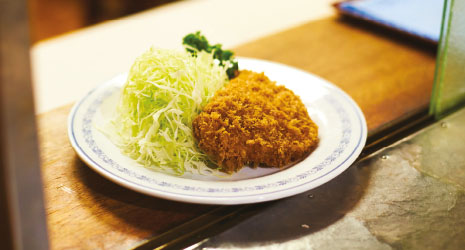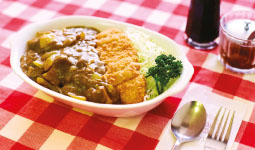Home > Highlighting JAPAN > Highlighting Japan October 2018 > From Meiji to the Present: Looking Back on 150 Years of Progress
Highlighting JAPAN


The Roots of Tonkatsu: A Delicious Fusion of East and West
Tonkatsu—the breaded, deep-fried pork cutlet so popular with the masses—was originally one of many Japanese twists on Western recipes imported to Japan, in this case France’s côtelette de veau. Here is the history of tonkatsu according to the first restaurant in Japan to put the dish on its menu.
Starting in the Meiji Period (1868-1912), Japan made rapid strides to establish itself as a modern nation, and along the way adopted many food-related cultural practices from the West. One recipe imported to Japan at that time was a French dish known as côtelette de veau, a veal cutlet coated in breadcrumbs and fried in a pan with butter.
The Western-style restaurant Rengatei, which opened in 1895 in Ginza and is still serving customers, felt that method made the cutlet too oily and overwhelming for Japanese tastes. Tonkatsu was born when Rengatei borrowed a technique from a Japanese culinary staple, tempura, deep-frying the breaded cutlet in a pot full of hot oil instead of panfrying it. The product was crisper and lighter, and more appealing to the Japanese palate. The breadcrumbs used in the batter also changed from stale breadcrumbs to soft fresh panko breadcrumbs, and coating the meat all over in tempura fashion made it even more tender and delicious. And instead of veal, comparatively cheaper cuts of pork were used. Tonkatsu debuted in 1899 under the name “pork cutlet” on the Rengatei menu.
Rengatei’s pork cutlet dish continued to evolve to fit the tastes of the times. To deal with a lack of cooks, the restaurant substituted finely chopped cabbage for the hand-cut château carrots and potatoes originally served alongside the meat. The restaurant replaced its own demi-glace sauce with a mix of two types of imported Worcestershire sauce, which produced a clean, tangy flavor that matched Japanese people’s preferences.
Despite the dish’s evolution being due largely to a lack of staff, tonkatsu is a great example of Western-style Japanese cuisine that has become a beloved standby. It also inspired the creation of a whole new range of dishes. The katsu sandwich, which uses tonkatsu as a sandwich filling, as well as the invention of katsu curry, which was the result of the chef indulging a customer’s wishes and secretly making an off-menu item—are just two of many whimsical culinary options derived from tonkatsu.
“What’s most important is for our diners to think of it as a nostalgic, familiar flavor,” says fourth-generation Rengatei owner Koichiro Kida. Although the recipe is actually the result of a series of improvements meant to suit the needs of a certain era, Rengatei’s goal is to give their tonkatsu a timeless taste.
For example, Kida asserted that selective breeding has made the pork used today better quality than that available during the Meiji, Taisho and Showa periods, but that while the quality has improved the taste should remain unchanged. When asked about the secret to deep-frying perfect tonkatsu, head chef Masaki Osawa replied that he balances the needs of the current era with the taste from long ago.
“We don’t throw out used oil—we preserve it to bring out a deeper flavor,” he explains. “We also sprinkle salt and pepper on only one side of the meat and place it in the refrigerator overnight to draw out the umami and tenderness. Those techniques haven’t changed since Rengatei’s beginning. On the other hand, we do try to go along with current trends like cutting off the fatty parts from pork loin to make it healthier.”
By the Meiji Period, pork farming was also flourishing in the Kanto region, but meat was still an expensive option that most commoners couldn’t obtain or afford. And as it turned out, the côtelette de veau dish was a bit too rich for the Japanese palate. After a period of trial and error, however, Rengatei created tonkatsu, which has gone on to become a dish beloved by many for more than a hundred years, both when cooked at home and as a popular meal when eating out.
© 2009 Cabinet Office, Government of Japan








